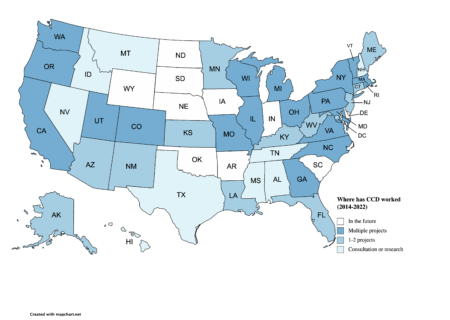Annual reports
Over the past decade, the Center for Civic Design has worked in 41 states plus DC. We’ve worked on all sorts of election administration topics, from ranked choice voting, to automatic registration, to poll worker training. Through it all, we’ve centered the experiences of voters and election administrators in our research and design work. Read on to see highlights from every year, as well as links to our annual reports.

Before CCD (2012)
Before CCD became an official organization, over 300 individuals contributed to the Kickstarter to bring our Field Guide Series to life. A decade after that kickstarter campaign, they continue to be used by election administrators across the country.
2015
Our favorite moment in 2015 was when California passed a law informed by our research.
We also… worked with Pennsylvania as it became one of the 31 states that now offer online or electronic registration. We redesigned the paper form with our partners at Oxide Design and helped the Pennsylvania team with the online form featuring simpler, clearer language. Continuing our effort to help election offices implement good design principles into forms, we also created a checklist of questions to ask about the usability of an electronic pollbook and a procedure for running a quick usability test to answer those questions.
2016
One of our favorite projects from 2016 was partnering with the Center for Tech and Civic Life and election officials to create electiontools.org, an online library of free or low-cost tech resources for election offices. We continue to update and refine the toolkit to this day.
We also… engaged 45 (of 58) counties in CA during our work on voter guides. Our guide, Designing a voter guide to an election contains a summary of what we learned from this project. In another Knight Foundation grant with DemocracyWorks and e.ThePeople (the platform behind vote411.org and many newspapers), we explored ways to deliver links to local election guides to voters). In the process, we learned so much about how to help people become informed voters.
2017
Our top highlight from 2017 was working with partners to develop vote by mail templates that are easy to use and recognize.
We also… worked closely with California’s Secretary of State’s office, county election administrators, print and mailing vendors, and the USPS to develop useful, legal vote-by-mail templates that are easy to implement and easy for voters to use. We continued our work on best practices for ranked choice ballot design, voter education, and display of results for single and multi-winner contests. Our report is now hosted at rankedchoicevoting.org.
2018
Our proudest moment in 2018 was when 49% of voters in California received vote-by-mail envelopes using CCD’s designs in the 2018 June primary and the November midterm elections.
We also… partnered with the CA state department of elections and county offices to improve poll worker effectiveness and the voter experience. We worked on modernization of voter registration systems at DMVs and in social services agencies, and have been involved with almost every major implementation of the test the forms and other information for voters. We’re proud to say that millions of new voters have registered in these systems since January 2018.
2019
Our biggest achievement of 2019 was when we reached a milestone of supporting 33 states or 65% of the country with our work.
We also… worked on Automatic Voter Registration, as it was adopted by 20 states, making it easier for 38% of potential voters in the U.S. to register and keep their registration up to date. We also taught our Election Design course at the University of Minnesota for the 5th time.
2020
During 2020, the year of vote by mail, we worked on ballot envelopes with election offices in 27 states, through a project we call Operation Envelope.
We also… designed pocket guides, a single piece of paper folded into a small booklet designed to provide enough information to get people a step closer to getting, marking and casting a ballot. We worked on HealthyVoting.org, a public election information site from We Can Vote, which combined accurate information for every state with the best advice from public health professionals. We also developed an interactive prototype for accessible ranked choice voting and tested it with voters with attention disabilities, voters with no use of their hands, and blind voters.
2021
Our top highlight from 2021 was working with partners in NYC to help make the largest introduction of ranked choice voting in the US a success.
We also… worked with the North Carolina State Board of Elections to redesign a number of their forms, including voter registration, absentee ballot request, and candidacy filing. In Pennsylvania, we tested ways to present options for voters on a “permanent notification list” for mail-in voting. We also conducted an analysis of voter signature forms on mail ballot envelopes and the process of making them easier to understand. Our research showed that with plain language, legally accurate declarations can be brought down from postgraduate levels to high school and even middle school levels.
See a timeline of projects in 2021
2022
Our favorite day from 2022 was the general election, when we helped run a successful pilot for a new end-to-end verification system.
We also… worked in 16 states and reached 53 million voters. We released tools for election administrators, conducted research studies and usability tests, and taught new skills across the county.
2023
Our favorite moments from 2023 were when two bills informed by our design and plain language recommendations were adopted.
We also… focused on building community partnerships. These partnerships have helped us learn more about how to tailor information to meet the needs of new voters and new citizens.

